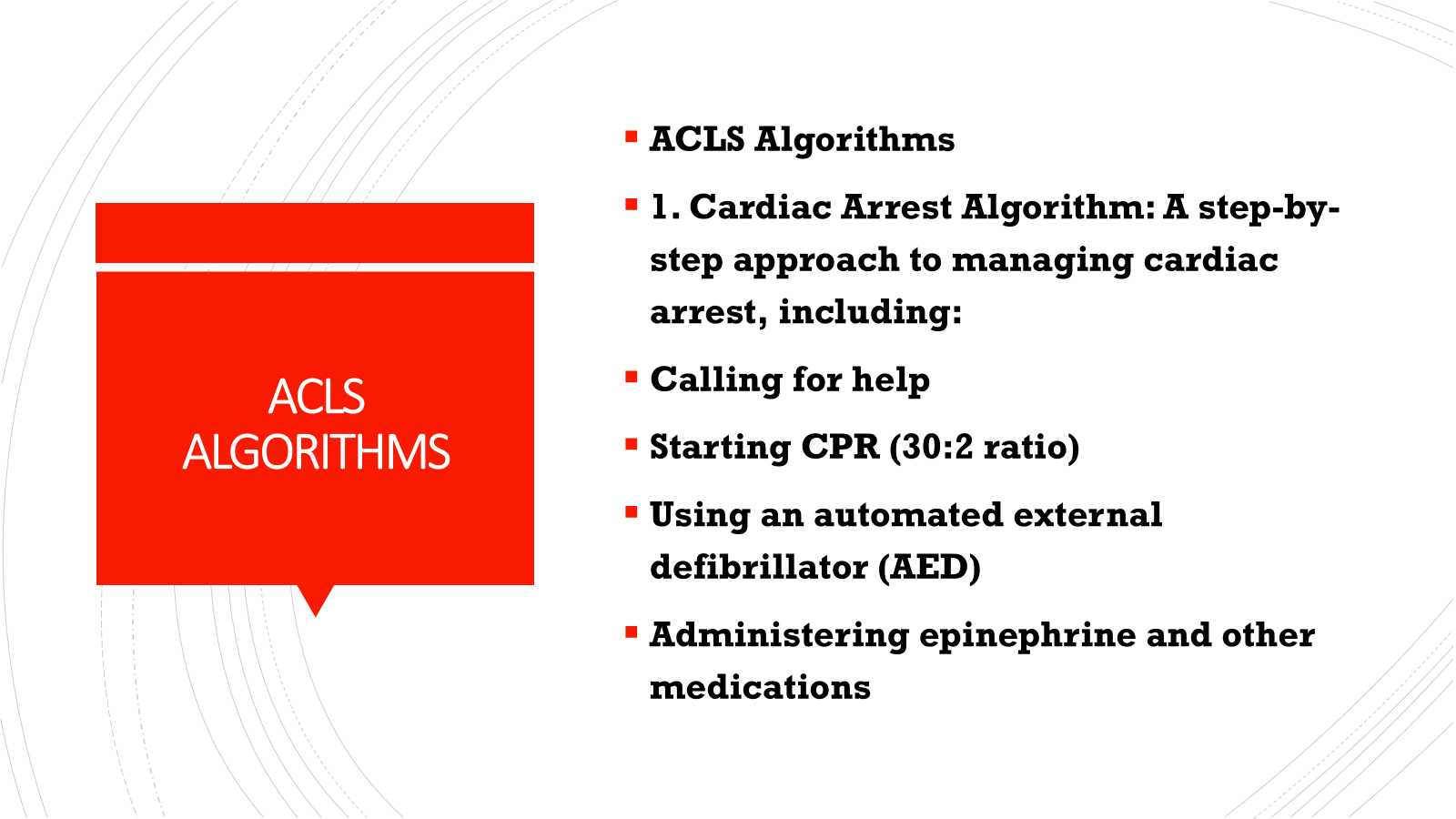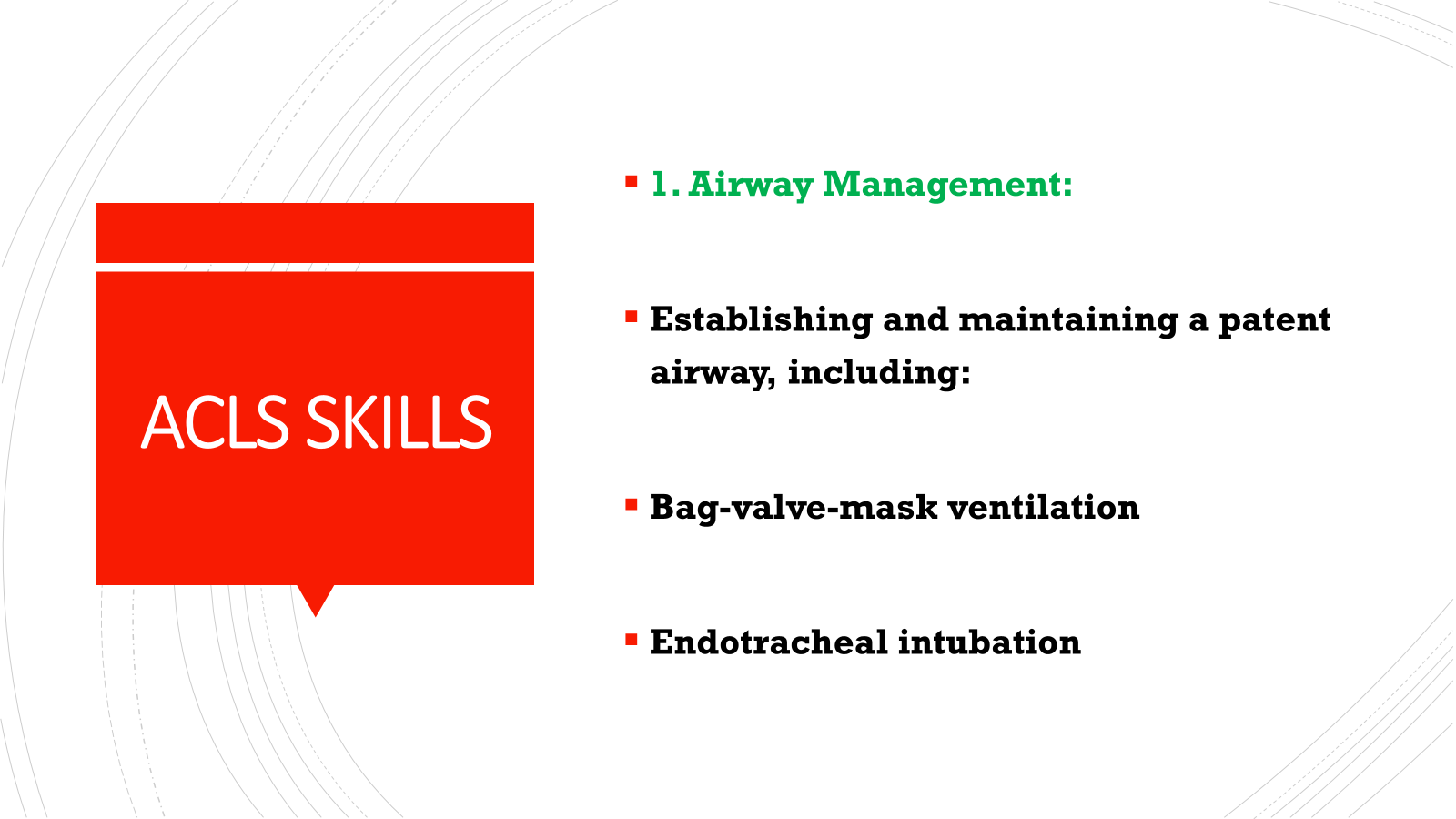Advanced Cardiovascular Life Support (ACLS): Full Overview
1. What is ACLS?
ACLS is a set of advanced medical interventions and protocols used by healthcare professionals to manage life-threatening cardiovascular emergencies. It goes beyond Basic Life Support (BLS) by adding advanced tools, medications, and procedures designed to treat patients in critical conditions, such as cardiac arrest, severe arrhythmias, and stroke.
ACLS aims to improve survival outcomes by quickly identifying and managing cardiovascular and respiratory emergencies, restoring blood circulation, and providing post-arrest care.
2. Key Components of ACLS
ACLS consists of multiple components, each critical to treating patients in emergency settings. Below are the key aspects of ACLS:
A. Cardiac Arrest Management:
-
Sudden Cardiac Arrest (SCA) is the leading cause of death in the U.S., often caused by conditions like arrhythmias or acute myocardial infarction (heart attack).
-
ACLS provides protocols to restore circulation and oxygenation in patients who experience cardiac arrest.
-
Chest Compressions: High-quality chest compressions are essential for maintaining circulation during cardiac arrest. This is a core element of both BLS and ACLS.
-
Defibrillation: Using an Automated External Defibrillator (AED) or manual defibrillator to deliver an electrical shock to the heart in cases of shockable rhythms (ventricular fibrillation or pulseless ventricular tachycardia).
-
Medications: Medications like epinephrine, amiodarone, and lidocaine are often used during cardiac arrest to treat arrhythmias or help restore normal heart rhythm.
-
B. Airway Management:
-
Proper airway management ensures that the patient’s lungs receive sufficient oxygen.
-
Endotracheal Intubation: A key component of ACLS, where a tube is inserted into the trachea to secure the airway and allow for mechanical ventilation.
-
Supraglottic Airway Devices: These are used as alternatives if intubation is not possible or practical in a time-sensitive situation.
-
Ventilation Support: Patients may require bag-valve-mask ventilation or mechanical ventilation if they are unable to breathe on their own.
-
C. Pharmacology:
ACLS protocols include the use of various medications to stabilize the patient’s condition:
-
Epinephrine: Often administered during cardiac arrest to stimulate the heart and increase perfusion.
-
Amiodarone: A medication used to treat arrhythmias like ventricular fibrillation or pulseless ventricular tachycardia.
-
Atropine: Used to treat bradycardia (slow heart rate) by blocking the parasympathetic nervous system and increasing heart rate.
-
Lidocaine: An antiarrhythmic drug used in cases of ventricular arrhythmias.
-
Magnesium Sulfate: For treating specific arrhythmias, like torsades de pointes.
-
Sodium Bicarbonate: Used to correct acidosis in some cases of prolonged resuscitation.
D. Rhythm Analysis and Management:
-
ECG Interpretation is critical to diagnosing arrhythmias and determining treatment:
-
Shockable Rhythms: These include ventricular fibrillation (VF) and pulseless ventricular tachycardia (VT), which require defibrillation.
-
Non-Shockable Rhythms: Asystole (flatline) and pulseless electrical activity (PEA) do not respond to defibrillation. In these cases, the focus shifts to CPR and drug administration (like epinephrine).
-
Synchronized Cardioversion: A procedure used for patients with unstable tachyarrhythmias (e.g., atrial fibrillation, atrial flutter), where a controlled shock is delivered in sync with the heart's rhythm.
-
E. Post-Cardiac Arrest Care:
-
After successful resuscitation, ACLS involves ensuring stabilization and prevention of further complications.
-
Targeted Temperature Management (TTM): Cooling the patient’s body temperature to 32-36°C for 24 hours after resuscitation can improve neurological outcomes in certain patients.
-
Oxygenation and Ventilation: Maintaining appropriate oxygen levels and ventilation is critical during the post-arrest phase.
-
Hemodynamic Support: Medications may be used to stabilize blood pressure and ensure adequate perfusion of vital organs.
3. ACLS Protocols for Specific Emergencies
A. Cardiac Arrest
-
Initial Step: Check for responsiveness and pulse. If no pulse, start CPR and call for help.
-
Defibrillation: If the rhythm is shockable (e.g., VF, pulseless VT), administer a shock.
-
Medication: Administer epinephrine every 3-5 minutes and amiodarone or lidocaine if indicated.
-
Reassess the rhythm every 2 minutes and repeat defibrillation if necessary.
B. Bradycardia
-
Identify Causes: Evaluate for reversible causes (e.g., hypoxia, electrolyte imbalances).
-
Initial Management: Atropine 1 mg IV for symptomatic bradycardia.
-
If ineffective, consider transcutaneous pacing, dopamine, or epinephrine.
C. Tachycardia
-
Stable Tachycardia: Use medications like adenosine or beta-blockers for rate control.
-
Unstable Tachycardia: Synchronized cardioversion may be required if the patient is symptomatic with signs of instability (e.g., hypotension, chest pain, altered mental status).
D. Stroke
-
Acute Ischemic Stroke: Rapid identification of stroke symptoms (FAST: Face, Arms, Speech, Time) is essential.
-
Administer thrombolytics (like tPA) if within the therapeutic window (typically 3-4.5 hours after symptom onset).
-
If not a candidate for thrombolytics, support with other interventions like blood pressure management and oxygenation.
E. Respiratory Arrest
-
If a patient stops breathing but still has a pulse, the primary focus is airway management and ventilation.
-
Use a bag-valve mask or endotracheal intubation to secure the airway and ensure adequate oxygenation.
4. ACLS Algorithm Summary
The ACLS protocols are organized into step-by-step algorithms to guide healthcare providers through various emergency scenarios. These include:
-
Cardiac Arrest: CPR, defibrillation, drug administration.
-
Bradycardia: Atropine, pacing, medications.
-
Tachycardia: Rate control, synchronized cardioversion, medications.
-
Stroke: Rapid identification, thrombolysis, management of blood pressure.
These algorithms help healthcare professionals make quick decisions during high-pressure situations to maximize patient survival.
5. ACLS Key Takeaways:
-
Timely Intervention: The sooner life-saving interventions like defibrillation and medication are administered, the higher the chances of survival and good outcomes.
-
Team-Based Approach: ACLS emphasizes the importance of teamwork in managing emergencies. Clear roles, effective communication, and coordination are essential.
-
Continuous Monitoring: After stabilization, continuous monitoring of vital signs, airway status, and cardiac function is critical to prevent complications.
Conclusion:
ACLS is an essential skill set for healthcare providers working in emergency, critical care, and intensive care settings. The protocols, ranging from immediate life-saving measures to post-arrest care, are designed to improve survival rates and enhance patient outcomes in cardiovascular emergencies. Understanding the specific interventions and medications, along with clear team communication, ensures effective management of life-threatening conditions.
''Complete Guide to ACLS Certification: Requirements, Process, and Renewal"
Introduction:
Advanced Cardiovascular Life Support (ACLS) certification is a crucial skill for healthcare providers working in emergency or critical care settings. Whether you’re a nurse, doctor, or paramedic, knowing how to respond to a cardiac emergency can save lives. This guide provides everything you need to know about ACLS certification, including the process, requirements, and how to maintain your certification.
1. What is ACLS Certification?
-
Definition of ACLS
-
Difference between ACLS and BLS (Basic Life Support)
-
Importance of ACLS in healthcare settings
-
Common medical emergencies where ACLS is needed
2. Who Needs ACLS Certification?
-
Healthcare providers (nurses, doctors, paramedics, etc.)
-
Job roles and settings where ACLS is required
-
Benefits of ACLS for healthcare professionals
3. ACLS Certification Requirements:
-
Prerequisites: Basic Life Support (BLS) certification
-
Minimum qualifications for enrolling in an ACLS course
-
Age, experience, and knowledge requirements
4. Steps to Get ACLS Certified:
-
Step 1: Enroll in an ACLS course
-
Online vs. in-person courses
-
Finding accredited organizations
-
-
Step 2: ACLS Course Content
-
Detailed breakdown of the course (airway management, pharmacology, ECG rhythm interpretation, etc.)
-
Hands-on skills practice
-
-
Step 3: ACLS Exam
-
Overview of the exam format (written exam and skills check)
-
Tips for passing the exam
-
5. Cost of ACLS Certification:
-
Average cost of ACLS courses
-
Financial aid or employer-sponsored certification programs
-
Hidden fees to watch out for
6. ACLS Renewal and Recertification:
-
When to renew ACLS certification
-
Renewal process and timeline
-
Online renewal options and refresher courses
-
What to expect during recertification
7. ACLS Course Providers:
-
List of reputable organizations offering ACLS training
-
How to choose the best ACLS course for your needs
-
Online ACLS courses vs. traditional classroom options
8. Common ACLS FAQs:
-
Can ACLS be taken online?
-
How long does ACLS certification last?
-
What happens if I fail the ACLS exam?
-
Can ACLS certification be used internationally?
9. Tips for Success in ACLS Training:
-
Study tips and resources for preparing for the ACLS exam
-
How to improve hands-on skills
-
Common mistakes to avoid during ACLS training
-
How to stay updated with ACLS guidelines
10. Conclusion:
-
Recap of ACLS certification’s importance
-
The impact of ACLS skills on patient outcomes
-
Final thoughts on choosing a certification provider and preparing for your course


















